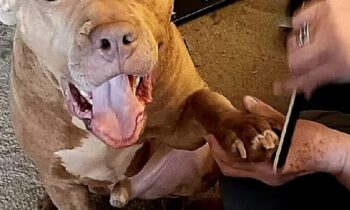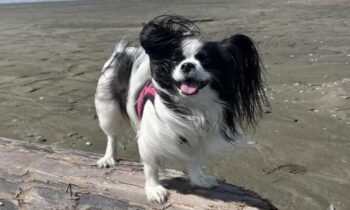
Anyone who walks a dog should know the basic etiquette, wouldn’t you think? It should be simple, taking a dog out for a constitutional—let him sniff, let her explore, both of you breathe fresh air, get some exercise, enjoy each other’s company.
But some dog owners so overlook the basics of common courtesy that other owners and their dogs make the choice to avoid walking entirely.
You don’t want to be that dog owner—the one who ruins it for everyone.
You want to be responsible, safe, and courteous to other dogs and owners.
What Are The Basics?
▪ Know the local laws.
▪ Use a leash or long line.
▪ No retractable leads.
▪ Bring extra baggies.
What Should You Bring?
▪ Baggies—more than you’ll ever need
▪ Wipes—for clean-up of dogs/humans
▪ Treats—small soft tasty morsels
▪ Toy/s—tug, squeaky, soft frisbee
▪ Water—for you and for your dog
▪ Phone—in case of emergency only
▪ Spray—deterrent against loose dogs
▪ Your ID—with emergency contacts
What Else Is Important?
Dogs should wear visible ID tags.
▪ Dogs may wear collars or leashes with phone numbers on them, commercially printed or home-made with a waterproof marker. Those should be easy to read for anyone who might find your loose dog.
▪ Local licenses and rabies tags should also be worn whenever the dog is outside your home. That information will be important to animal control officers and veterinarians who might be involved in getting your loose dog returned home to you.
▪ Update the contact info on your dog’s ID when it changes. Outdated ID info is one of the most common causes of lost pets not being returned promptly to their owners.
▪ Have the microchip checked at the dog’s annual exam. Update the microchip registration info for any changes.
Don’t walk anywhere without proper clean-up equipment.
▪ Clean up thoroughly if your dog defecates anywhere.
▪ Do not allow your dog to “mark” on non-public uprights.
▪ Don’t walk on private property without the owners’ permission.
▪ Wear safe and appropriate clothing and comfortable shoes.

Photo by Kim Imel
Don’t take your dog off leash anywhere it’s not legal—not even to potty.
▪ You simply cannot call yourself a responsible pet owner if you allow your dog to charge off into the underbrush in a public park to defecate, no matter how much you rationalize that the dog’s droppings will make great fertilizer. That’s just wrong and you know it. You must bag your dog’s poop.
▪ Don’t use the “he won’t poop on leash” excuse. He’d better learn and you’d better teach him, because some day it’s not going to be just a matter of your own convenience (and your basic distaste for dealing with your own dog’s droppings). Some day, he’s going to be staying overnight in a vet clinic and if he doesn’t eliminate when a staffer has him out on leash, he’s going to be uncomfortable.
▪ You may be asked, “What do his droppings look like?” When you can’t answer, the truth becomes obvious—you’re not picking up his poops. You take him out on leash to “do his business” or you have a fenced yard where your dog eliminates. Either way, you must be there, in a public place with him on a leash, picking up his droppings within seconds . . . or in your own yard, soon after, regularly scooping up the poop. It’s your responsibility as a dog owner, whether you like it or not.
Don’t dump baggies full of poop in a stranger’s garbage bin.
You wouldn’t mind if someone dropped a bag full of dog poop in your garbage bin? Neither would I, but believe it or not, some people do mind. Don’t take a chance on offending someone by leaving your garbage in their garbage bin. Don’t give dog owners a bad name. Carry that poop with you!
Don’t drop baggies full of poop on the ground and leave them.
You think you’ll pick those baggies up “on your way back,” but how often will you forget? No one should have to pick up a baggie full of your dog’s fresh poop in a public area or in the driveway of their own home. Figure out how to transport those poop-filled baggies home!
Don’t take your dog off leash anywhere it’s not legal—even to run free.
▪ Find a safe place for your dog to run.
▪ Off-leash cannot be safe if it’s illegal.
▪ Dog parks are one option, but dog parks are not for all dogs. Do your due-diligence on safety issues first by visiting a dog park without your dog. Don’t return with your dog if anything you see concerns you, from the physical set-up to the participants’ behavior, dog or human. Consider visiting when the dog park is not crowded.
▪ Look for alternatives that may be available—private dog parks with vetted canines, safely fenced areas that may be rented, friends with safe yards and friendly dogs?
Don’t approach other dogs closely.
▪ Is your dog friendly? Good for you.
▪ It doesn’t matter—the other dog isn’t.
▪ Allowing your dog to approach dogs you don’t know is not safe and it’s not sensible. There is nothing to be gained by such behavior—not for your dog and not for you. Assuming that other dogs and their owners will welcome your approach is selfish and thoughtless. Why would you want to take a chance that your dog or the other dog would not have a good experience? Are you so incapable of controlling your own dog that you’re unable to stop her from lunging at or jumping on other dogs?
What if a loose dog approaches you?
▪ Have a plan. Practice with your dog.
▪ You may choose to use a deterrent—spray, air horn, shock stick. (Again, due-diligence is required. Find out what’s legal to use in your jurisdiction, then experiment to see what works for you.) Train your own dog to not be frightened by whatever deterrent you choose. Train yourself to use your chosen deterrent safely and competently. No deterrent is foolproof—be extremely careful.
▪ You may choose to display, on your dog, a written warning. “GIVE ME SPACE” is common. You don’t owe anybody an explanation, of course, but you’ve got to hope that asking for space will encourage other dog owners to kick in their common courtesy. It doesn’t always work.
▪ Don’t expect others to know what a particular color of leash or scarf or harness indicates. You need to be more obvious. Words are good, but choose the words carefully. You do not want to label your dog as potentially dangerous, even if she’s wearing a cute shirt with those words on it!
▪ You may end up having to ask—even beg—other dog owners to control their dogs. This sort of exchange can quickly devolve into the too-often-heard “But my dog’s friendly!” I know many owners whose instinctive response is, “My dog isn’t” (or even better, “But I am not!”). I can’t suggest any pat phrases or shouted retorts that work in every situation. You’ll have to play it by ear and do your best!
▪ Anger and nastiness are infrequently effective.
▪ Your dog will probably do best if you respond calmly and with confidence to any approaches by off-leash and/or out-of-control dogs and their owners. You will probably do best if you can find areas to walk your dog that are not popular with many other dog-walkers or, better yet, where other dog-walkers practice common courtesy and encourage others to do the same.
▪ Friends and neighbors whose dogs get along well and have good leash manners may choose to band together to walk as a group—not only because dog-walking can be a pleasant social experience for both dogs and owners, but also because a larger group of dogs and humans may deter unwanted approaches from loose or out-of-control dogs and their thoughtless owners. Discuss the group’s strategy for dealing with unknown dogs and owners, and practice your plan together often!
Bring what you need to deal with whatever might happen.
You’re not necessarily expecting the worst, but you’re prepared for it. That goes for deterring an out-of-control dog approaching you with unknown intentions, or for dealing with your own dog’s sudden explosion of diarrhea in the middle of a walk.
Not comfortable with the way your dog behaves on a walk?
You can get the guidance and encouragement you need by signing up for a class at a reputable positive training school for dogs and their owners, or by working individually with an ethical positive trainer with excellent local references.
As always, do your due-diligence and choose wisely!



